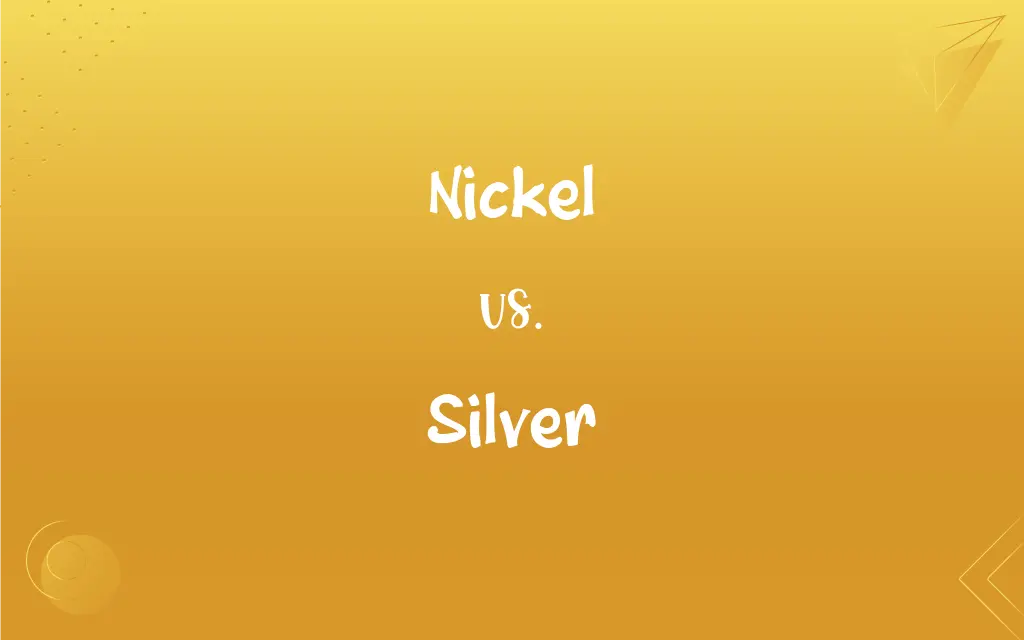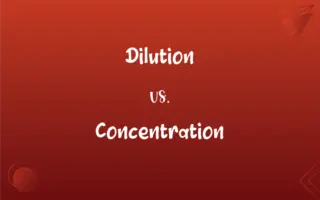Nickel vs. Silver: What's the Difference?
Edited by Aimie Carlson || By Janet White || Published on January 22, 2024
Nickel is a hard, silvery-white metal resistant to corrosion, commonly used in alloys and plating, whereas silver is a precious, highly conductive, and malleable metal, used in jewelry, electronics, and silverware.

Key Differences
Nickel is a versatile metal found in various alloys, offering strength and corrosion resistance, while silver is known for its luster and high electrical conductivity, making it valuable in both jewelry and electrical applications.
Nickel, while silvery in appearance, doesn't match the brightness and sheen of silver, which is renowned for its distinct, radiant luster.
In terms of value, silver is a precious metal with significant economic worth, often used as an investment, whereas nickel is more abundant and widely used in industrial contexts, making it less expensive.
Nickel is often used in stainless steel production and coinage, contributing to its hardness and resistance to oxidation. Silver, on the other hand, is softer, making it ideal for decorative items and silverware but less suited for high-stress applications.
Nickel can cause allergic reactions in some people, especially when in contact with skin, unlike silver, which is generally hypoallergenic and widely used in fine jewelry.
ADVERTISEMENT
Comparison Chart
Appearance
Silvery-white, less lustrous
Bright, shiny, and highly reflective
Economic Value
Less expensive, more abundant
Precious metal, higher economic value
Common Uses
Alloys, plating, industrial applications
Jewelry, silverware, electrical components
Physical Properties
Hard, corrosion-resistant
Soft, highly conductive, malleable
Allergenic Potential
Can cause skin allergies
Generally hypoallergenic
ADVERTISEMENT
Nickel and Silver Definitions
Nickel
It is a silvery-white lustrous metal with a slight golden tinge.
The new coins were made from a nickel-copper alloy.
Silver
It is a soft, white, lustrous transition metal, highly conductive of electricity.
Silver is used in high-end audio cables due to its conductivity.
Nickel
Nickel is used extensively in alloys and for plating metal objects.
Nickel plating is commonly used for corrosion protection.
Silver
Silver has been used for centuries in currency, ornaments, and utensils.
The family heirloom was a set of antique silver flatware.
Nickel
Nickel is a transition metal, hard, ductile, and ferromagnetic.
Nickel-based batteries are known for their durability.
Silver
Silver is a chemical element with the symbol Ag and atomic number 47.
Silver jewelry often tarnishes over time, requiring polishing.
Nickel
Nickel is a chemical element with symbol Ni and atomic number 28.
Stainless steel contains nickel to enhance its corrosion resistance.
Silver
It is a precious metal, known for its reflective appearance and malleability.
The artist crafted a delicate sculpture from pure silver.
Nickel
It is resistant to corrosion and oxidation in moist environments.
Nickel alloys are ideal for high-temperature and high-strength applications.
Silver
Silver compounds are used in photographic films and X-rays.
Silver halide crystals in photographic paper react to light exposure.
Nickel
Symbol Ni A silvery, hard, ductile, ferromagnetic metallic element used in corrosion-resistant alloys, stainless steel, catalysts for hydrogenation, and batteries, and for electroplating. Atomic number 28; atomic weight 58.69; melting point 1,455°C; boiling point 2,913°C; specific gravity 8.902; valence 0, 1, 2, 3. See Periodic Table.
Silver
Symbol Ag A lustrous white, ductile, malleable metallic element, occurring both uncombined and in ores such as argentite, having the highest thermal and electrical conductivity of the metals. It is highly valued for jewelry, tableware, and other ornamental use and is widely used in coinage, photography, dental and soldering alloys, electrical contacts, and printed circuits. Atomic number 47; atomic weight 107.868; melting point 961.78°C; boiling point 2,162°C; specific gravity 10.50 (20°C); valence 1, 2. See Periodic Table.
Nickel
A coin of the United States or Canada worth five cents.
Silver
This metallic element as a commodity or medium of exchange.
FAQs
What's the main use of silver in electronics?
Silver is used for its excellent electrical conductivity in components like contacts and conductors.
Are nickel alloys strong?
Yes, nickel alloys are known for their strength and resistance to heat and corrosion.
Can nickel be a pure element?
Yes, nickel can be found in its pure form, but it's commonly used in alloys.
Is silver a good investment?
Silver can be a valuable investment due to its status as a precious metal.
What colors can silver be alloyed into?
Silver alloys can range in color, but it's usually white and lustrous.
Can silver tarnish?
Yes, silver can tarnish and requires regular cleaning to maintain its luster.
Does nickel react with water?
Nickel is corrosion-resistant and does not react significantly with water.
Is nickel used in jewelry?
Yes, but it's often alloyed with other metals due to potential skin allergies.
What's the role of nickel in batteries?
Nickel is used in various battery types, including nickel-cadmium and nickel-metal hydride batteries.
Is nickel magnetic?
Nickel is ferromagnetic, meaning it is attracted to magnets.
Are nickel allergies common?
Yes, nickel allergies are relatively common, especially from prolonged skin contact.
How is silver mined?
Silver is extracted from ore through a variety of mining processes.
What's sterling silver?
Sterling silver is an alloy containing 92.5% silver and 7.5% other metals, usually copper.
Is silver used in photography?
Yes, silver compounds are essential in traditional photographic films and papers.
Can nickel be polished to a high shine?
Yes, nickel can be polished, but it doesn't achieve the same luster as silver.
How does nickel resist corrosion?
Nickel forms a protective oxide layer, preventing corrosion.
Is silver used in medicine?
Silver has antibacterial properties and is used in medical applications and wound dressings.
What's the price difference between nickel and silver?
Silver is generally more expensive than nickel, reflecting its status as a precious metal.
What's the difference in weight between nickel and silver?
Silver is denser and heavier than nickel.
Are nickel and silver recyclable?
Both metals are highly recyclable without loss of quality.
About Author
Written by
Janet WhiteJanet White has been an esteemed writer and blogger for Difference Wiki. Holding a Master's degree in Science and Medical Journalism from the prestigious Boston University, she has consistently demonstrated her expertise and passion for her field. When she's not immersed in her work, Janet relishes her time exercising, delving into a good book, and cherishing moments with friends and family.
Edited by
Aimie CarlsonAimie Carlson, holding a master's degree in English literature, is a fervent English language enthusiast. She lends her writing talents to Difference Wiki, a prominent website that specializes in comparisons, offering readers insightful analyses that both captivate and inform.































































